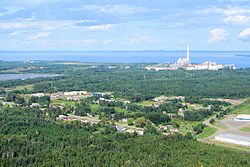Fort William First Nation
| Fort William 52 | |
|---|---|
| Indian reserve | |
| Fort William Indian Reserve No. 52 | |
 |
|
| Coordinates: 48°18′N 89°16′W / 48.300°N 89.267°WCoordinates: 48°18′N 89°16′W / 48.300°N 89.267°W | |
| Country |
|
| Province |
|
| District | Thunder Bay |
| First Nation | Fort William |
| Area | |
| • Land | 58.31 km2 (22.51 sq mi) |
| Population (2011) | |
| • Total | 860 |
| • Density | 14.7/km2 (38/sq mi) |
| Website | fwfn.com |
Fort William First Nation is an Ojibwa First Nation reserve in Ontario, Canada. The administrative headquarters for this band government is south of Thunder Bay. As of January 2008[update], the First Nation had a registered population of 1,798 people, of which their on-Reserve population was 832 people.
Fort William First Nation has a two rink arena which is home to the Thunder Bay Bearcats of the Superior International Junior Hockey League and has a fitness centre overlooking rink 1. A business park in the eastern end of the community is home to the head offices of Wasaya Airways and the band offices, among others.
The First Nation have reserved for themselves the 5,815.1 hectares (14,369 acres) Fort William Indian Reserve 52, which serves as the land base for the First Nation.
The Fort William Reserve, located on the western end of Lake Superior adjacent to the city of Thunder Bay was set aside under the provisions of the Robinson-Superior Treaty in 1850. The north shore of Lake Superior is the southern edge of the Canadian Shield, vast country of rock scraped clean by glaciers and waterways. The traditional territories occupied and used by the Chippewa’s at Fort William and their residence stretch from Pigeon River to the south, north to Treaty 9 boundary and east to Lake Nipigon.
The Fort William Reserve was created in 1853, as a condition of the 1850 Robinson-Superior Treaty. The Chief and Headmen who signed the Treaty intended that the Reserve would provide not just for their children, but for their grandchildren’s grandchildren. However, most of the best Reserve land was taken within about three generations.
...
Wikipedia

